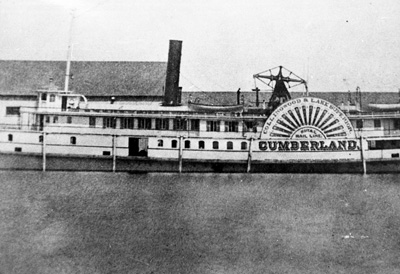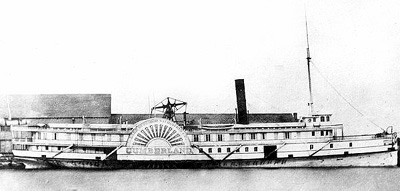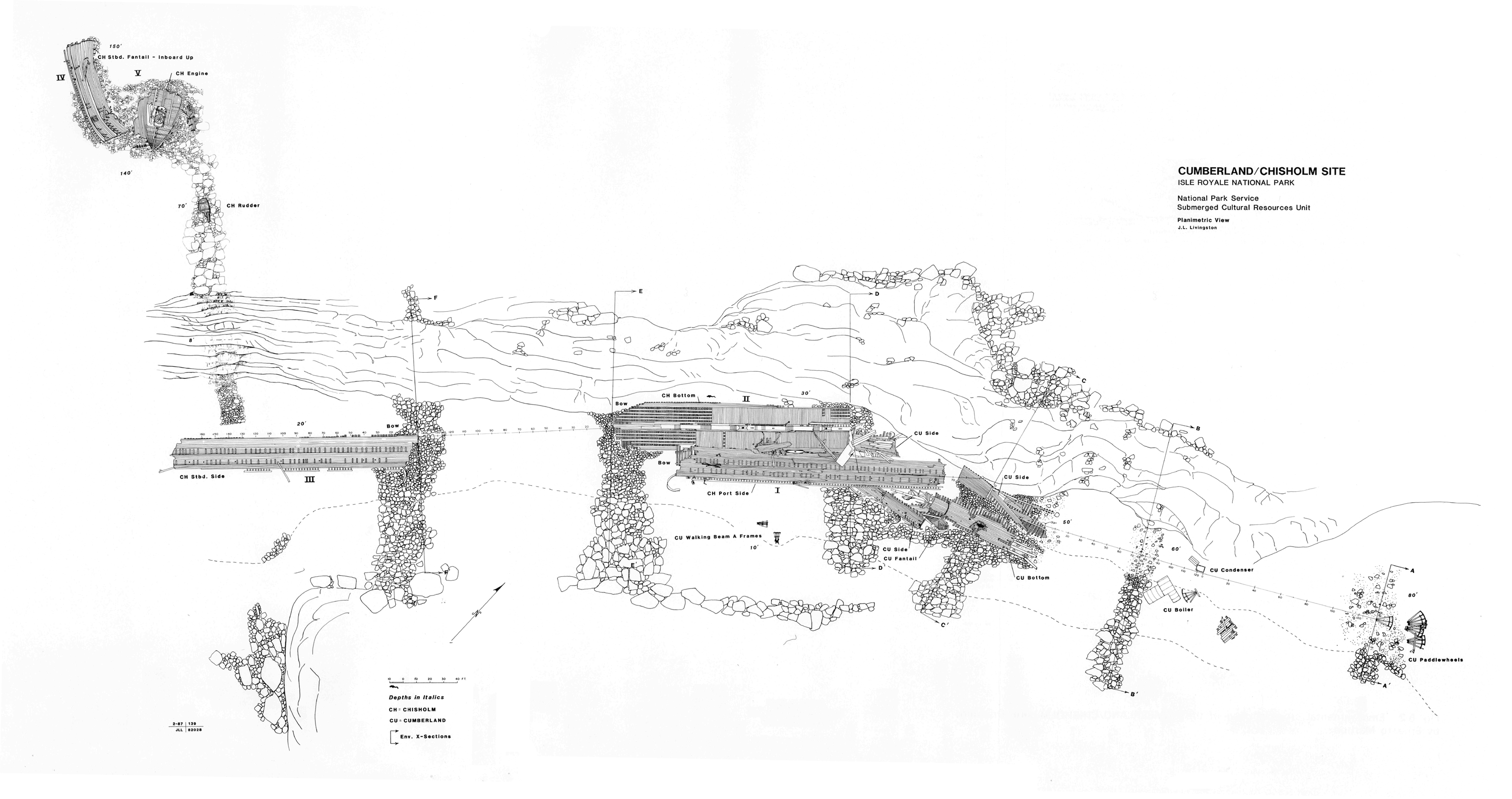Panoramic001.jpg)
SS Cumberland
Quick Facts
1871
Melanchthan & Simpson
Melanchthan & Simpson
204 feet
418 tons
Walking Beam Engine
Lake Superior Navigation Co. Ltd.
Lake Superior Navigation Co. Ltd.
Passengers and general merchandise
Lake Superior Navigation Co. Ltd.
Lake Superior Navigation Co. Ltd.
$35,000 or $40,000
Canadian
7/25/1877
Near Rock of Ages Lighthouse
Minimum 20 feet; maximum 80 feet
0
84001732
T
he side-wheeler CUMBERLAND was built in 1871 at Port Robinson, Ontario, by Melanchthon Simpson for Charles Perry and Co. It was launched Wednesday August 9, 1871 (Detroit Telegram Aug. 15, 1871). The vessel was named for Fred W. Cumberland, general manager of the Northern Railway, parent company of the Toronto and Lake Superior Navigation Company, which had the ship designed and built to run the Duluth and Collingwood or Owen Sound route.
The railroad men who formed the navigation company were pioneers in the Lake Superior trade prior to the construction of the railroads in the area. The towns of Collingwood, and later Owen Sound and Midland, were the main points of rail connection between train and Lake boat. The Superior ports were all served by Lakes vessels at the time of formation of the new navigation company. CUMBERLAND, along with ALGOMA (previously named CITY OF TORONTO and RACINE) were the core of the new enterprise, which incorporated connections between the railroad and steamship line. Later, CHICORA would join the line (Williams 1909:43-47).
CUMBERLAND was a typical example of the Great Lakes sidewheel steamers built from the late 1840s through the 1880s. The first of the 200-foot steamers appeared on the Lakes in the early 1840s, and by the next decade had assumed the classic configuration as represented by CUMBERLAND and the dozens of other steamers produced for the passenger and package trade on the Lakes.
The ship was powered by a vertical "walking-beam" engine with one boiler and a single stack. CUMBERLAND was reported to be 208 feet on the keel and 214 feet overall with a beam of 28 feet, 43 feet 8 inches overall. The draft was 10 feet 6 in., and it was 229 tons burden, 750 tons gross measurement. The engine was rated at 400 horsepower (Detroit Free Press Oct. 1, 1871). The ship had a round fantail stern, and its cabins were warmed by steam. The steamer had paddle wheels 30 feet in diameter (Ibid. Oct. 4, 1871).
Operational History

SS Cumberland: Historic Photograph Collection, ISRO Archives.
CUMBERLAND'S first full season of navigation was 1872, a year that initiated a series of incidents that were to afflict the steamer throughout its relatively short history of operation. CUMBERLAND carried about 600 passengers and a heavy load of freight, horses and cattle on its first 1872 trip (Toronto Mail May 11, 1872; Meaford Monitor May 16, 1872).
September 1872 was a stormy month, and some vessels were lost. The schooner MAPLE LEAF was swamped near Isle Royale and eventually capsized in rough weather. The captain and crew were able to abandon ship and were taken to Silver Islet. During the wreck, the captain reported he had sighted CUMBERLAND, but it was not able to render assistance due to the heavy seas ( Meaford Monitor Oct. 17, 1872).
In November of 1872, CUMBERLAND was frozen in the ice in Bear Lake in the St. Mary's River. Captain Orr, the chief engineer and four of the crew arrived on foot in Collingwood on December 27. Several days after them, 18 of the crew arrived after making the 20-day trek down the north shore of Georgian Bay. According to their reports, they suffered terrible weather and privation on their journey; all were frostbitten. Captain Orr had left CUMBERLAND in the charge of the first mate, with the steward, stewardess and two waiters left on board (Toronto Mail Dec. 27, 28, 1872; Marquette Daily Mining Journal January 4, 1873). There were also 50 passengers aboard (Toronto Mail Dec. 11, 1872).
In early November 1874, nearly on the anniversary of being frozen in the ice, CUMBERLAND was caught in a storm between Sault Ste. Marie and Prince Arthur's Landing (renamed Port Arthur in 1884) and very nearly wrecked. CUMBERLAND may have been near Passage Island when it was caught (Meaford Monitor Nov. 10, 1874).
The caulking came out of the hold planks in several places and the ship began leaking badly. To keep from sinking, either 75 (Duluth Minnesotian Nov. 7, 1874) or 150 (Ashland Press Nov. 14, 1874) head of cattle and some freight were thrown overboard. It was reported that $3,000 worth of cattle, sheep and hogs belonging to Brown Bros, and all the deck cargo were dumped overboard (Meaford Monitor Nov. 10, 1874). CUMBERLAND arrived at Prince Arthur's Landing with 6 feet of water in the hold, and promptly sank (Duluth Minnesotian Nov. 7, 1874; Ashland Press Nov. 14, 1874).
The November 1875 newspapers reported CUMBERLAND was ashore and scuttled. The vessel was again caught in a late season storm and went ashore three miles from Silver Islet at Lee or T Harbor in a blinding snowstorm, with gale-force winds from the east (The Daily Globe Nov. 3, 1875; Cleveland Herald Nov. 5, 1875). There was little damage, and the steamer, with passengers and freight intact, arrived in Thunder Bay November 4, after being pulled free by tugs (Cleveland Herald Nov. 8, 1875; The Daily Globe Nov. 5, 1875). The freight carried by CUMBERLAND included "copper ore, fish, and fourteen span of horses, and about 100 passengers" (Chicago Inter Ocean Nov. 8, 1875).
On Sept. 15, 1876 CUMBERLAND ran aground at Owen Sound. While trying to get the vessel off by using a line wrapped on the shaft of the wheel, Capt. Orr was injured. The line snapped and broke both of the captain's legs. Captain Parsons took the command for the trip (Duluth Minnesotian Sept. 23, 1876).
Wreck Event

SS Cumberland: HCGL/MAIN: Dow Collection, Image ID: 001985, BGSU Archives.
CUMBERLAND was delayed for three days while enroute to Prince Arthur's Landing. The vessel had been grounded on a bar in Nipigon Harbor (Thunder Bay Sentinal July 26, 1877), arriving in Prince Arthur's on Tuesday (July 24). The ship probably cleared port the same day, as was its practice.
CUMBERLAND started taking on water, and its passengers were transferred to an upbound American boat she met. Later, on the 25th, CUMBERLAND struck Rock of Ages reef (Thunder Bay Sentinal July 26, 1877). The day was mild when CUMBERLAND struck. The weather was dry and clear, with a light southwest to south-southwest breeze blowing (Menagerie Isle Light Station Log July 23, 24, 1877).
CUMBERLAND struck the reef going at a speed sufficient to push its bow solidly aground. It was reported that all the forward half of the vessel was on the reef. Several tugs and steamers unsuccessfully attempted to pull it off. (It was also reported that had CUMBERLAND run 100 feet to either side, it would have missed the reef (Duluth Minnesotian Aug. 4, 1877). The steamers QUEBEC and FRANCIS SMITH worked on the stranded ship. These steamers parted all their lines in the unsuccessful attempt to remove the sidewheeler. CUMBERLAND was reported in bad shape, "lying 18 inches out amidships (Chicago Inter Ocean July 30, 1877). Some of the freight was loaded onto FRANCIS SMITH, a ship owned by the same line (Chicago Inter Ocean Aug. 1, 1877).
The newspapers ran frequent reports on the progress of the attempts to save CUMBERLAND, and it was clear from the stories that the people of both Duluth and Prince Arthur's hoped she would be saved. The Duluth Tribune (Aug. 3, 1877), for instance, printed the comments: "We hope the fears entertained that she will go down before she reaches Collingwood will not be realized, for she is a trim, staunch and fast sailing craft, and would be greatly missed from our commerce."
The following announcement of the sale of materials from the wreck appeared September 1, 1877 (Toronto Globe):
Salvage Auction Sale of Effects
Saved from the Wreck of the Steamer Cumberland
on View Today at 56 Yonge Street
The subscribers have received instructions to sell on behalf of the underwriter by public auction, at the warehouse, No. 56 Yonge St. the whole of the effects saved from the wreck of the Steamer CUMBERLAND, consisting of two metal lifeboats, two wooden yawl boats, two anchors and cable chains, about two tons Manilla rope, blocks, tackle, capstans, 130 life preservers, zinc pails, wheel and wheel stand, wire rope and rigging in large quantities, deck pumps, hoisting machinery, steam gauges, engine gong, pony engine, steam heater, tools etc., also the whole of the furniture saved, which is in excellent condition, consisting of 100 cane seat dining chairs and stools, 125 spring and mixed mattresses, 100 sponge and feather pillows, card and extension dining tables, gilt mirrors, 20 pieces velvet carpet, a large number of crimson and gold armchairs, sofas,and setees, superb rosewood Pianoforte, and many more articles, as well as the hull, engines and boilers of the steamer as she now lies off Isle Royale Island.
Unfortunately the worst fears were realized. The wreck was abandoned August 12 (Chicago Inter Ocean Aug. 13, 1877). By August 18, it was rapidly going to pieces, and had broken entirely in two (The Marquette Mining Journal Aug. 18, 1877). The same newspaper reported it a total loss by August 25. The owners were already negotiating for the purchase of the Union Steamboat Company vessel ATLANTIC as a replacement. The loss of CUMBERLAND was put at $50,000. It had been insured for $34,000 (Duluth Minnesotian Herald Aug. 11, 1877).
CUMBERLAND remained visible until the end of August. The steamer FRANCIS SMITH, down bound from Duluth, reported the wreck was in the same position as when it was abandoned (Toronto Globe Aug. 31, 1877).
CUMBERLAND was entirely submerged by early September. The Duluth Minnesotian (Sept. 8, 1877) reported that "She is now quietly laying on the bed of Lake Superior. Some wreckers went to look for her lately, but could not find her."
Shipwreck Site Map
Engines salvaged and placed in Canadian Steamer Columbia. Large sections of wooden hull, side-wheel and boiler remain.

Hover
SS Cumberland/Chisholm Site Map, Submerged Cultural Resource Unit, J.L. Livingston, February 1987, ISRO Archives.
Citations:
- Isle Royale Shipwrecks. December 15, 1965. Isle Royale National Park Archives, Resource Management Records: Branch Chief Era, CRM History (ACC#ISRO-00614, Box 117), Houghton, MI.
- Lenihan, Daniel. Submerged Cultural Resources Study. Santa Fe, N.M: Submerged Cultural Resources Unit, National Park Service, 1987. Print.